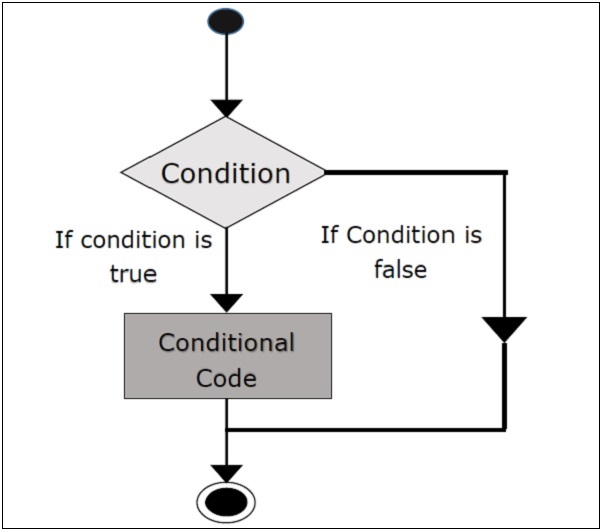
- Scala 教程
- Scala - 首頁
- Scala - 概述
- Scala - 特性
- Scala - 環境搭建
- Scala - 構建工具 (SBT)
- Scala - 基本語法
- 資料型別和變數
- Scala - 資料型別
- Scala - 變數
- Scala - 字串
- Scala - 陣列
- Scala 運算子
- Scala - 運算子
- Scala - 算術運算子
- Scala - 關係運算符
- Scala - 邏輯運算子
- Scala - 位運算子
- Scala - 賦值運算子
- Scala 條件語句
- Scala - if else
- Scala 迴圈語句
- Scala - 迴圈語句
- Scala - while 迴圈
- Scala - do-while 迴圈
- Scala - for 迴圈
- Scala - break 語句
- Scala 類和物件
- Scala - 類和物件
- Scala - 訪問修飾符
- Scala 方法和函式
- Scala - 函式
- Scala - 按名稱呼叫函式
- Scala - 帶命名引數的函式
- Scala - 帶可變引數的函式
- Scala - 遞迴函式
- Scala - 預設引數值
- Scala - 高階函式
- Scala - 巢狀函式
- Scala - 匿名函式
- 部分應用函式
- Scala - 柯里化函式
- Scala 集合
- Scala - 集合
- Scala - 列表
- Scala - 集合
- Scala - 對映
- Scala - 元組
- Scala - 迭代器
- Scala - 選項
- Scala 模式匹配
- Scala - 模式匹配
- Scala - 異常處理
- Scala - 提取器
- Scala - 正則表示式
- Scala 檔案 I/O
- Scala - 檔案 I/O
- Scala 高階概念
- Scala - 閉包
- Scala - 特質
- Scala 有用資源
- Scala - 快速指南
- Scala - 線上編譯器
- Scala - 有用資源
- Scala - 討論
Scala - if else 語句
本章將帶您瞭解 Scala 程式設計中的條件構造語句。以下是大多數程式語言中常見的典型決策 if...else 結構的一般形式。
流程圖
以下是條件語句的流程圖。

if 語句
“if”語句由一個布林表示式後跟一個或多個語句組成。
語法
“if”語句的語法如下所示。
if(Boolean_expression) {
// Statements will execute if the Boolean expression is true
}
如果布林表示式計算結果為真,則將執行“if”表示式內部的程式碼塊。否則,將執行“if”表示式結束後的第一組程式碼(在結束花括號之後)。
嘗試以下示例程式以瞭解 Scala 程式語言中的條件表示式(if 表示式)。
示例
object Demo {
def main(args: Array[String]) {
var x = 10;
if( x < 20 ){
println("This is if statement");
}
}
}
將上述程式儲存在 Demo.scala 中。以下命令用於編譯和執行此程式。
命令
\>scalac Demo.scala \>scala Demo
輸出
This is if statement
If-else 語句
“if”語句後可以跟一個可選的else語句,當布林表示式為假時,該語句將執行。
語法
if...else 的語法如下所示:
if(Boolean_expression){
//Executes when the Boolean expression is true
} else{
//Executes when the Boolean expression is false
}
嘗試以下示例程式以瞭解 Scala 程式語言中的條件語句(if-else 語句)。
示例
object Demo {
def main(args: Array[String]) {
var x = 30;
if( x < 20 ){
println("This is if statement");
} else {
println("This is else statement");
}
}
}
將上述程式儲存在 Demo.scala 中。以下命令用於編譯和執行此程式。
命令
\>scalac Demo.scala \>scala Demo
輸出
This is else statement
If-else-if-else 語句
“if”語句後可以跟一個可選的“else if...else”語句,這對於使用單個 if...else if 語句測試各種條件非常有用。
使用 if、else if、else 語句時,需要注意以下幾點。
一個“if”可以有零個或一個“else”,並且它必須位於任何“else if”之後。
一個“if”可以有零個到多個“else if”,並且它們必須位於“else”之前。
一旦“else if”成功,就不會測試任何剩餘的“else if”或“else”。
語法
以下是“if...else if...else”的語法:
if(Boolean_expression 1){
//Executes when the Boolean expression 1 is true
} else if(Boolean_expression 2){
//Executes when the Boolean expression 2 is true
} else if(Boolean_expression 3){
//Executes when the Boolean expression 3 is true
} else {
//Executes when the none of the above condition is true.
}
嘗試以下示例程式以瞭解 Scala 程式語言中的條件語句(if-else-if-else 語句)。
示例
object Demo {
def main(args: Array[String]) {
var x = 30;
if( x == 10 ){
println("Value of X is 10");
} else if( x == 20 ){
println("Value of X is 20");
} else if( x == 30 ){
println("Value of X is 30");
} else{
println("This is else statement");
}
}
}
將上述程式儲存在 Demo.scala 中。以下命令用於編譯和執行此程式。
命令
\>scalac Demo.scala \>scala Demo
輸出
Value of X is 30
巢狀 if-else 語句
巢狀if-else語句始終是合法的,這意味著您可以在另一個if或else-if語句中使用一個if或else-if語句。
語法
巢狀 if-else 的語法如下所示:
if(Boolean_expression 1){
//Executes when the Boolean expression 1 is true
if(Boolean_expression 2){
//Executes when the Boolean expression 2 is true
}
}
嘗試以下示例程式以瞭解 Scala 程式語言中的條件語句(巢狀 if 語句)。
示例
object Demo {
def main(args: Array[String]) {
var x = 30;
var y = 10;
if( x == 30 ){
if( y == 10 ){
println("X = 30 and Y = 10");
}
}
}
}
將上述程式儲存在 Demo.scala 中。以下命令用於編譯和執行此程式。
命令
\>scalac Demo.scala \>scala Demo
輸出
X = 30 and Y = 10